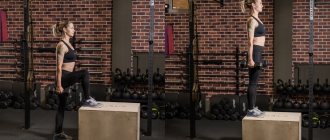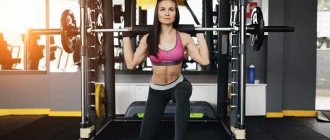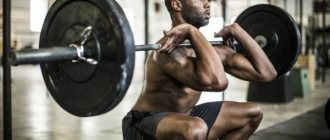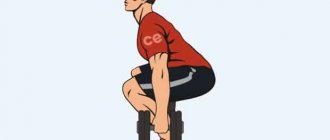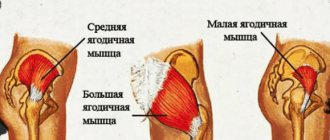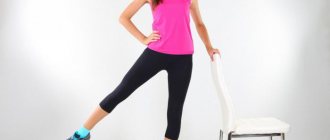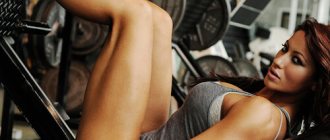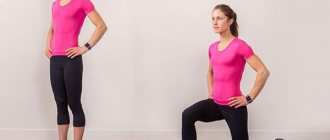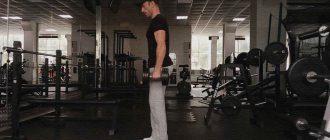What areas will we use?
This article will describe squats with dumbbells for girls for the buttocks and thighs. We will use:
- Adductor muscle (we wrote about it above).
- The back surface of the biceps femoris.
- Buttocks.
- The front of the thigh.
Some techniques are designed for complex pumping of the hips and buttocks, but there are “problem areas” that require special exercises. For example, the adductor muscle of the thigh (inner thigh).
The skin in this area is much thinner - this makes it less elastic. This is where fat accumulates. Thin skin and a dense layer of fat make the area flabby and aesthetically unattractive. We will discuss exercises for this and other problem areas separately.
Note! Some exercises additionally work your back. It won't make you more attractive, but it will make you healthier if done in moderation. The work also slightly involves the calf muscles and shoulders. We still focus on the butt and hips.
The benefits and harms of squats with dumbbells
If you're not yet sure whether to add squats to your workout, consider their benefits:
- Effectively help with excess weight. Using the techniques described, we say goodbye to fat by increasing muscle mass. Squats will help you quickly form an attractive figure, even if you are overweight.
- They have pleasant side effects. It’s not for nothing that squats are included in the warm-up of track and field athletes. They will significantly increase your overall flexibility and speed.
- Helps cope with back pain. As we mentioned above, some exercises involve the back muscles. This improves posture and helps cope with pain when walking for a long time (the main thing is not to get carried away).
- Improve blood circulation. Thanks to better functioning of blood vessels in the pelvic area, you can normalize metabolism, tighten the skin and improve its general condition.
- Reduce the risk of injury. It is very difficult to stretch or damage reinforced tissue. The muscles become not only strong, but also flexible.
- Very comfortably. You can exercise at home or in the gym.
With the correct technique, suitable weighting material and the absence of contraindications, squats cannot harm your body.
Note! Unsuitable (too heavy) dumbbells can lead to knee problems. Track and field athletes, football players and bodybuilders often encounter such troubles. The latter is helped to relieve the load by special protection - chondroprotectors. You won't need them unless you want to build a lot of muscle mass.
Problems can also start if you make mistakes in the exercises. We will talk about them later.
Other exercises
In addition to the squats for girls presented above, the muscles of the legs and buttocks are stressed by performing another popular exercise: lunges. Lunges can be done with or without dumbbells and are useful for strengthening muscles.
In the case of performing lunges with dumbbells, the squat program is as follows. Starting position: back straight, feet shoulder-width apart, arms along the body. Dumbbells are located on the sides. As you exhale, lunge forward with one leg until it is parallel to the floor.
It is important to note that the knee should not protrude beyond the toe. The second leg moves to a 90° position, bends without touching the floor
Returning to the starting position occurs by returning the leg in front.
The exercise has a number of variations: lunges can be done both forward and backward, without stopping, “walking” forward with lunges. The wider the step, the higher the effect of the exercise. An analogue of lunges are squats on one leg, both with and without dumbbells or a barbell. In this case, the gluteal muscles and hamstrings receive greater load at home.
Squats for girls on one leg can also be performed using a bench (Bulgarian split squat). The technique is as follows: at a distance of one step from the bench, stand with your back to it, bring your leg back and place your foot on the bench with your heel up. The second leg bends slightly at the knee. Squats are done down to a level parallel to the floor, taking into account that the knee should not protrude beyond the toe.
Gyms have special machines for working the muscles of the buttocks and legs. For example, the equipment in the gyms allows you to perform Smith squats. In addition, a popular exercise machine is the incline bench. The squat program includes an exercise called hyperextension. It works like this:
- you need to lie down on the machine, rest your feet on the lower roller;
- the hips should be located on the upper bolster at a level above 10 cm from the edge;
- the back should be straight and completely relaxed;
- bending is performed downwards;
- The back is raised to a level parallel to the floor, while the gluteal muscles are tensed.
You can make the exercise more difficult using weights or weights.
To provide additional load to the hamstrings, exercises are performed on a special simulator. To do this, you need to lie face down on a bench and grab the handle in front with your hands. The knees hang slightly from the pillow. The legs are placed behind a special roller, and then it is raised by bending the legs at the knees. When bending, it is necessary to tense the gluteal muscles.
Leg presses with wide stance are also performed on a special machine. The inner thigh is worked. To do this, the feet are placed on a special platform at shoulder width, preferably closer to the edges. By pressing your heels on the platform, it is raised and then lowered. At the same time, your back should remain straight and not come off the pillow. The simulator allows you to perform the exercise with both legs at the same time, or one at a time.
Using a bench, weights or dumbbells, you can perform the pelvic lift exercise. The technique for performing it is as follows: lie down on a bench, resting your shoulder blades on the edge, then place a pancake or dumbbell on top in the groin area, working the muscles of the buttocks by lowering and raising the pelvis. An analogue of this exercise is performing a pelvic lift while lying on the floor, both with and without weights.
If the main goal of training is weight loss, then the squat program should have a number of repetitions, for example 3-5 sets of 15-20 repetitions. The weight should not be too heavy.
If the goal of the training is to increase muscle mass, then it is worth reducing the number of repetitions to 5-8 with 3-5 approaches. In this case, the weight is taken quite large. The effect of the exercise is achieved when at the end of the exercise there is practically no strength left. The effect can be observed after a month.
When should you not squat?
Before starting squats, we recommend that you consult a physical therapist. If not, at least read all the contraindications.
Squats with dumbbells should not be performed if you have problems with the spine, scoliosis, varicose veins, hernia, sciatica or hypertension. Women with cardiovascular disease and joint pain should also not exercise.
We warn young mothers: you can do squats no earlier than 6-7 weeks after pregnancy.
Execution technique
Initial position
- To squat, you will have to stand on step platforms, stands or stacks of plates. For most people, bending the knee at the amplitude of a squat will be accompanied by the dumbbell hitting the ground;
- For dumbbell half rows, you can stay on the floor. This movement is often mistakenly called a squat, but it is in it that the back is more inclined, due to which part of the length of the legs is “hidden”;
- The dumbbell is grasped by the discs with your hands, it is advisable not to hold the weight on your fingertips;
- The back is kept straight, the shoulder blades are brought together;
- Place your feet with your heels slightly wider than your shoulders. Getting into a split if you cannot squat until your thighs are parallel to the floor is pointless;
- In one motion, the knees straighten and the athlete stands up
Movement
- From a standing position, the dumbbell is lowered to the floor until it touches and rises;
- First, the athlete spreads his knees in alignment with his toes and begins to bend them;
- Then, as it were, he “retracts” the pelvis under himself and lowers himself;
- The goal is that the pelvic bones should fall into the plane of the knees or slightly lower;
- You can hold your back upright only if it is comfortable and does not cause pain in the hip joint
Squats with dumbbells between legs. Plie squats
When will the result be noticeable?
Immediately focus on working on yourself. You will feel fit within a week, but you will be able to get a really impressive butt no earlier than after 6 months. If you are reading this in winter, start today, everything will work out by summer.
To speed up the process, follow these guidelines:
- Follow a diet - give up baking and sweets. Eat meat, eggs, fish, cheese products. Try to eat a balanced diet. Without protein, muscles will not grow.
- You don't need to exercise every day. Three times a week will be enough. Exercise for 40 minutes until you feel tired. After training, do a short massage to disperse lactic acid.
- Choose a weight that is comfortable for you and periodically (the main thing is gradually) increase it.
If you do everything correctly, after 3 months a good relief will begin to emerge, the buttocks will become more voluminous and elastic.
Dumbbell squat technique
We will show you 3 exercises that comprehensively involve the muscle groups we have already mentioned. This will be enough for you to achieve the desired results.
Classic squat
The classic squat is known to every person who has ever been to the gym. This is one of the first exercises that the trainer shows - the main load is aimed at the quadriceps.
It can be done with a barbell, kettlebells or other weights. There is no big difference in effectiveness, but it is safest to do this with dumbbells.
Step 1 – take dumbbells and stand with your feet shoulder-width apart (a little wider if possible). Your palms should be facing the floor and your eyes should be straight ahead.
Step 2 – As you inhale, begin to lower yourself down, bending your knees. Make sure that your heels are “glued” to the floor and that your knees do not go too far beyond the level of your toes.
Step 3 - Stop when your thighs are parallel to the floor. Push your heels off the floor and begin to rise up to the starting position. Exhale with effort.
Repeat the squat 12-15 times for 2-3 approaches. Rest between sets.
Note! This exercise can also be performed with bent elbows or one dumbbell. If you train with one dumbbell, grab it by the weight plate with both hands.
Plie squat
The term “plie” came to gyms straight from ballet. It literally means “to bend the leg.” The feet are in the first position - as far apart as possible. This is exactly the exercise we talked about above. It will help remove fat from the inner thigh and tighten it.
Step 1 - Hold one dumbbell with both hands, place your feet wider than shoulder-width apart, and turn your toes out so that you can draw a straight line along your feet. If you feel that your hips are not tense enough, turn your toes even further to the sides. Move your pelvis back a little, straighten your back in a natural arch.
Step 2 – Start squatting as you exhale, holding the dumbbell down. Your knees should point in the same direction as your feet. Squat to your maximum. Ideally, your thighs should be parallel to the floor, as in a classic squat.
Step 3 – Having reached the maximum point, hold for 1-2 seconds. As you exhale, slowly rise up. Do not return completely to the starting position - the exercise will be more effective if your legs are tense all the time.
Perform 10-15 of these squats per set. 3-4 approaches per workout will be enough.
Note! The plie squat requires a good stretch. You won’t be able to sit low enough right away. To increase the effectiveness of the exercise, do a special warm-up before training. We'll talk about it below.
Sumo squat
The sumo squat is very similar to the plie. They work the inner thighs, quadriceps and glutes. Classic squats put stress on the back muscles. Sumo doesn't use them.
Step 1 – Grasp one dumbbell with both hands by the disc and stand with your feet wider than shoulder-width apart. Turn your toes approximately 45 degrees.
Step 2 – Inhale and lean back slightly. Start squatting so that your toes and knees do not move inward. Pull your pelvis back to the maximum. At the extreme point, the thighs should be parallel to the floor.
Step 3 – As you exhale, return to the starting position.
This is a moderate intensity exercise. Perform it 10-15 times, do 3-4 approaches.
Note! When you squat below parallel to the floor, the gluteus maximus receives more load. But in this case, the load on the knee joint increases significantly. It's better not to do that.
Analysis of the exercise
What muscles work
The main movers in the exercise are the entire array of gluteal muscles, quadriceps, and hamstrings. The hamstrings and buttocks are prioritized. The longus dorsi muscle also works; it is impossible to say that the back does not work here.
The latissimus and abdominal muscles work as stabilizers. During the grip, the hands and forearm muscles are used.
Preparing for the exercise
Beginners can start with an anatomically comfortable foot placement. There is no need to immediately “get into the splits” and try to sit down in this position. This usually ends with inflammation of the hip joint and discomfort in the lumbar region.
Stretching is important, but you won’t be able to “pull” yourself into the correct starting position. Therefore, it is recommended to simply do the exercise and perform “pre-stretching” in a dynamic manner.
Usually this movement comes first or second in a beginner’s plan, so first perform mfr, cardio warm-up, joint warm-up, and a couple of approaches without weights or with minimal weight.
Squat with Dumbbell Between Legs. Inner thighs + buttocks
Difference between plie and sumo squat
In fact, there is only one difference - in the position of the back. In both options in fitness (not bodybuilding, not powerlifting, but in physical education for health), it is better to place your feet at the width that is convenient for comfortable lowering into a squat.
The movement in both cases looks like this:
- In sumo, it begins with bending and spreading the knees, but the pelvis is lowered down and pulled back slightly due to the tilt of the back. There is no need to specifically stretch your pelvis back, especially at the start, as this will lead to insufficient stretching of the gluteal muscles;
- In plié, the back is almost vertically straight. It is more convenient for beginners to hold the apparatus on their chest or learn to squat with their arms crossed on their shoulders.
Recommendations for implementation
The dumbbell squat is suitable for both beginners and experienced ones. If the exercise does not allow you to achieve the desired amplitude, it is recommended to use a more classic foot placement and a goblet squat.
The movement is best learned without weights, adding a dumbbell as you toast technical mastery.
The exercise is technically quite complex, so if you can’t do a plie with a dumbbell lowered in your hands, you can do a goblet squat or box squat with a truncated amplitude until the hip joints get used to the work.
The technical details are:
- The movement begins like any squat, with the knees spread in the same direction as the toes;
- Socks should be kept to the sides, but at such a width that it is comfortable for you;
- The back is kept straight, but the lower back may be slightly arched;
- Rounding the shoulders forward is allowed
A few more tips
While you have not yet started training, pay attention to a few nuances that will help increase your productivity.
Warm-up
How do muscles grow? Under the weight, they receive microtraumas, and are later restored by the body. They are restored with the expectation that the load may be repeated again. Thus, the fabric becomes more flexible, stronger and more voluminous. Without heating, the fibers are destroyed prematurely, without waiting for a surge of growth hormone.
By neglecting to warm up, you also increase the load on your joints and may end up with a sprain.
To ease into squats, take a few minutes to:
- Stretching the internal and posterior thigh muscles.
- Bends and twists of the body.
- Warming up the knees and Achilles tendon.
If possible, run at a slow pace for 500 meters on a treadmill. After warming up, your heart rate should rise to 100 beats per minute - this means that your body is ready for training.
What weight should I take?
If you have just started pumping your hips and buttocks, try doing a few workouts without weights. You need to learn technique and balance. If you are confident in your abilities, take dumbbells:
- 2 kg. Suitable for weight loss. They need to be practiced at a faster pace. Preferably with rhythmic music.
- From 2 to 12 kg. Suitable for building and strengthening muscles. Increase the weight if life doesn't seem so bad during your workout.
Note! Choose a weight that you are comfortable with. It is better to reduce the load if you feel that you cannot complete the given set of approaches.
Recommendations
Despite the apparent simplicity of such squats, there are several nuances that should not be overlooked. Otherwise, you can break the entire execution technique or training scheme, and this is fraught not only with disruption of the final result, but also with unpleasant consequences. So learn from experienced professionals the little tricks of big sport.
- Squats must be preceded by a short warm-up.
- Your back should be kept straight all the time, with a natural arch in the lower back.
- No jerking - all movements in squats are performed smoothly.
- You can't bring your knees together.
- When returning to the top point, do not straighten your knees completely, otherwise this will create additional stress and lead to injury.
- It is not recommended to tilt your head and look at your feet.
- Follow proper breathing technique. Inhale - lower, rise - exhale.
- The approximate weight of dumbbells for girls is 5 kg, for men - 10.
- The number of approaches is from 3 to 5. The interval between them is no more than 2 minutes. Each set contains 15-20 repetitions.
- Observe contraindications: problems with the spine and joints, varicose veins and thrombophlebitis, exacerbation of any diseases, pregnancy.
Squats with dumbbells are good because they are presented in different versions, among which you can always choose something for yourself. They allow you to practice independently, without a trainer, at home. This is a projectile that will not require you to spend any money or have any intense physical training. But the results obtained at the end of the month will delight you with a beautiful, sculpted figure and excellent health.
Consider other squat variations:
- According to the Neumyvakin system;
- Bulgarian;
- Zerchera.
The most common mistakes
Exercises are of no use if you do them incorrectly. Some mistakes in training can only harm your figure, not improve it. Most often when doing squats, beginners:
- Lift your heels off the floor! You can't do that. If you can’t do a deep squat without lifting your heels, then you have problems with stretching your calf muscles. Sit on the floor, stretch your legs forward, grab your toes and reach forward towards your toes without bending your knees. This will help.
- The knees go inwards! Make sure your knees point in the same direction as your toes. If you can’t follow this, pull a rubber expander band above your knees. You will feel a change in tension and automatically bring your knees into the correct position.
- Squat not deep enough! Without a deep squat, the glutes are not engaged. Usually the problem is that the hip joint is not flexible enough. Perform hamstring stretches.
The back is rounded! To easily learn not to round your back, do the exercise near a wall. Touch it with your hands directly in front of you and do a squat without lifting your hands. Try it, you will succeed.
